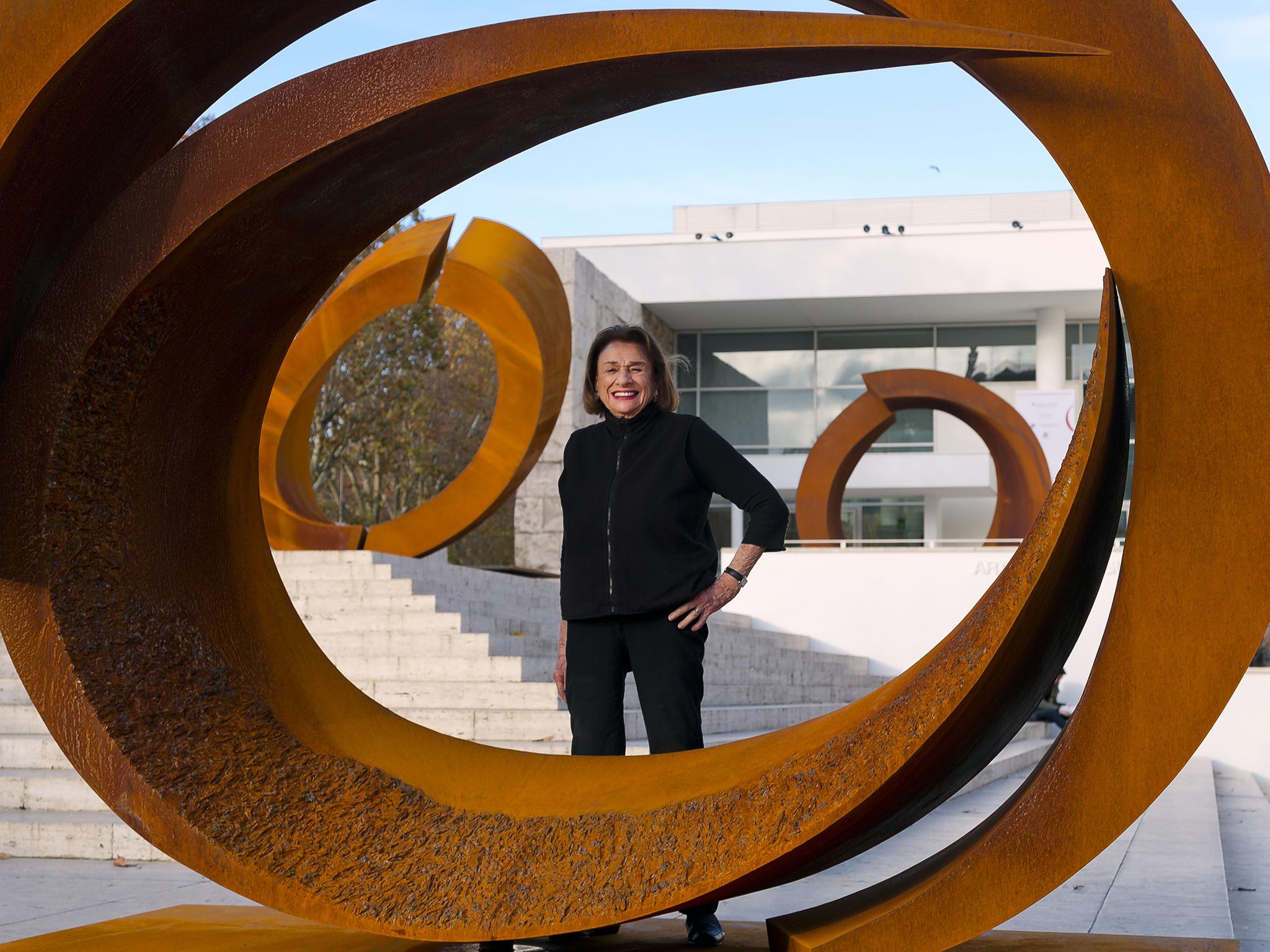Beverly Pepper: Sculptor famed for her bold metal monuments
An idiosyncratic talent, she was lauded for her Manhattan Sentinels in New York and the Todi columns in Italy

When the American sculptor Beverly Pepper applied for an artist’s residency in Piombino, Italy, in 1962, she discovered that one of the requirements was a knowledge of welding. Having lied about her metal-working skills to get the appointment, Pepper engaged a local blacksmith to teach her in secret and embarked upon a crash course that would inform the rest of her creative life.
Pepper, who has died aged 97, was born Beverly Stoll in Brooklyn, New York, to Irwin Stoll and Beatrice Stoll, nee Hornstein. Irwin was a furrier and amateur boxer. Beatrice took in laundry to make ends meet but her passion was politics and she volunteered for the National Association for the Advancement of Colored People. Pepper was also influenced by her paternal grandmother, Rose, once a teenage Menshevik, who had to flee Vilnius after insulting the Tsar. Speaking of her childhood, Pepper told The Sunday Telegraph: “There was nothing I ever thought would limit me because my mother and grandmother were very strong women.”
Pepper was always destined to be an artist. She remembered how, as a six-year-old, she took a dollar without permission from her mother’s bag to buy a packet of drawing pencils. When the theft was discovered, Pepper was beaten by her father, whom she later described as “brutal”.
At 16 Pepper applied to the Pratt Institute to study advertising, photography and industrial design. She was accepted and invited to join a sorority. The invitation was withdrawn when the sorority members discovered that Pepper was Jewish. She also discovered that, after her first year, she would not be allowed to study industrial design because it was considered unfeminine. Pepper would encounter sexism throughout her career and felt she was perhaps overlooked in favour of male artists working in a similar way.
Graduating from Pratt, Pepper was conscious that she needed to make a living and became a commercial art director, working for Coty and Decca Records. However, she continued to paint and took night classes in philosophy at Brooklyn College. And in 1949, she left behind a blossoming career in advertising and her first marriage, to Lawrence Gussin, to go to Paris to study at the Academie de la Grande Chaumiere, where she studied with the Cubist painters Andre Lhote and Fernand Leger. While in Paris, Pepper also trained at the cookery school Le Cordon Bleu.
It was while she was studying in Europe that Pepper met her second husband, Curtis “Bill” Pepper, an ex-air force man turned writer, on a visit to Rome. At the time, Pepper was on her way to meet a boyfriend in Venice, but her meeting with Bill was a coup de foudre and they were married within three months.
The Peppers had two children, Jorie Graham, a Pulitzer Prize-winning poet and John Randolph Pepper, a photographer and theatre director. When the family settled in Rome, where Bill worked as Mediterranean bureau chief for Newsweek, they frequently had Cinecitta actors over for dinner. Pepper counted Fellini and Michelangelo Antonioni as friends.
In 1952 Pepper had her first exhibition at Rome’s Galleria dello Zodiaco. That same year she published the first of two cookery books she would write to support her art. She began her professional career in fine art as a painter but after a visit to Angkor Wat in 1960, she became fascinated by sculpture and took her first steps towards the monumental, site-specific art that would bring her to worldwide attention.
Pepper refused to be tied to any particular artistic style. “I don’t like to get caught in any kind of mental trap,” she said. “When I’m working I feel and see. Things fall from my mind to my hands … you have to listen to the materials.” If Pepper had a trademark, it was perhaps her innovative use of materials. She worked in iron and bronze but she was also among the first sculptors to use industrial alloys.
Having learned to weld in a pinch in Piombino, three years later, in 1965, she had a residency at the US Steel Factory in Pennsylvania, where she made her first sculptures in Cor-Ten. She loved the red-brown hue that Cor-Ten, known as weathering steel, takes on as it oxidises.
Pepper worked on a variety of scales, from the small to the monumental. She took inspiration from ancient Greek, Roman and Middle Eastern history. Her work was displayed at the Centre Pompidou in Paris, in the Metropolitan Museum of Art in New York, the Smithsonian Institution’s Hirshhorn Museum and in the Sculpture Garden in Washington.
Pepper’s sculptures were often strongly tied to place. She created the four cast-iron Manhattan Sentinels that stand in New York’s Federal Plaza. In Barcelona, Pepper designed the Sol I Ombra Park, which has the air of an iron-age fort when viewed from the sky. However, Italy was perhaps the greatest beneficiary of Pepper’s work. For L’Aquila, devastated by an earthquake, Pepper created an “amphisculpture”, seating 1,000, from local stone.
In 1979 Pepper created a series of eight-metre-high columns for the 11th century square at the heart of Todi, where she and her husband had lived since the 1950s. When she first set the columns in the square, they were considered controversial. In 2019 they were welcomed back to the city with great excitement. Pepper had refined the columns for the Venice Biennale. Returned to Todi, they now stand in a specially designed park containing a number of sculptures Pepper donated to the city.
Pepper’s husband Bill died in 2014. She is survived by their daughter and son.
Beverly Pepper, sculptor, born 20 December 1922, died 5 February 2020
Join our commenting forum
Join thought-provoking conversations, follow other Independent readers and see their replies
Comments